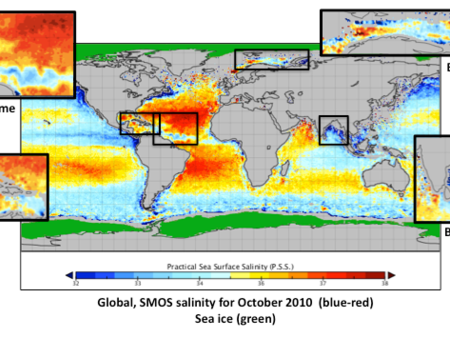Approach
Scientific, technical and methodological approaches are presented here
From the constructed database of all coincident EO, in situ and model data, with sub sections for each of our case study regions, we will initially produce algorithms for a suite of the carbonate system parameters. The database will be used to generate algorithms for each parameter and region, where sufficient in situ measurements exist in the database before the period April 2010 to April 2012, using standard multiple linear regression analysis.
Any available data between April 2010 and April 2012 will be used as our test period, thus allowing us to produce outputs using all available EO, model and climatology data, which we can compare with in situ data that was not used for parameterization of the algorithms. The number of available data will determine the criteria used for matchup, for example if we have enough in situ data with valid EO data
on the same day we will use daily EO data, otherwise we will relax the criteria to ensure that sufficient data are included. In addition to testing against in situ data, we intend to additionally compare the skill
of outputs produced using EO products with products from models and climatologies.
In order to solve the carbonate equations and estimate pH and ΩA , we need temperature (SST), salinity (SSS) and at least two of the carbonate parameters pCO2, AT, DIC and pH. Given these, we calculate the concentration of hydrogen ions, [H+], iteratively using the methods contained in the SeaCARB package (Lavigne and Gattuso, 2011), from which pH and ΩA can be derived.
In the case of global algorithms we will use the maximum in situ dataset to test generic types of algorithms from the literature, as well as where appropriate create novel algorithms fitted to global data using multiple linear regression. We expect that many of these algorithms will perform poorly on a global scale, but any global algorithms that are within a reasonable limit could potentially be more useful than regional or multiregional algorithms in comparing with global model output. Therefore a systematic survey of the skill of global algorithms will be useful as a context against which the skill of regional algorithms can be compared.
For the regional case study sites, we will perform a ‘round robin’ test of algorithms for each carbonate parameter in each region to establish the algorithms that provide the closest representation of seasonal and spatial accuracy in relation to the in situ measurements.
We will construct a large database of all coincident EO and in situ data with sub sections for each of our case study regions. We will use this calibration/validation dataset to calibrate algorithms for each parameter and region, where sufficient in situ measurements exist in the database. When we have identified the best performing algorithm for each parameter and region (where performance is determined from a number of criteria), we will use pairs of parameters to calculate pH and ΩA, and evaluate which has the greatest success in predicting the regional in situ pH and ΩA. Using the most successful algorithm pair, we will produce monthly maps of pH and ΩA together with their uncertainties. This analysis will ensure that the chosen algorithms provide the ‘closest’ constraint of the carbonate system.
Partial pressure of CO2 in seawater (pCO2)
In-water pCO2 is expected to rise in line with atmospheric pCO2, so in all cases we will correct pCO2 to a reference year using the monthly average atmospheric pCO2 from Mauna Loa Observatory. We have a large dataset of pCO2 measurements in the SOCAT database (Bakker et al., 2013), which we can use to calibrate and test global and regional algorithms. Our first pCO2 algorithm will simply be the SOCAT climatology of pCO2 from the Oceanflux GHG project corrected for SST (°C) using
(pCO2) corr = (pCO2)CLIM exp[0.0433 (SSTAATSR – SSTCLIM) – 4.35x10-5 {(SSTAATSR )2 - (SSTCLIM )2}] (Takahashi et al., 2009)
This has the advantage of simplicity and requires only SST from EO data, but is likely to work only where SOCAT has good data coverage (hence the climatology is representative) and inter-annual and spatial variability is small. It will also serve as a reference against which other EO algorithms can be compared.
The pCO2 algorithms most commonly found in the literature are based on SST and chl. However, in the Bay of Bengal Sarma et al. (2011) relate pCO2 primarily to SSS and secondarily to SST, while in the Caribbean, Gledhill et al. (2008) relate ΔpCO2 = (pCO2)SW – (pCO2)AIR to the CO2 solubility K , and in the Barents Sea, Lauvset et al. (2013) relate fCO2 (closely related to pCO2) to SST, chl and mixed layer depth in the summer, and to SSS in the winter.
In the North Sea, Borges et al. (2010) relate pCO2 normalized to 10°C to SSS and chl. In all regions we will test the novel principles of fitting ΔpCO2 as a function of K instead of pCO2 as a function of SST and SSS, and of normalizing pCO2 to a standard temperature instead of using SST as a fit parameter.
Total Alkalinity (AT)
AT is primarily a function of SSS, with some parameterizations in the literature showing a secondary dependence on SST. Hence use of SMOS data is particularly important for AT. Takahashi and Sutherland (2013) relate potential alkalinity, which is AT plus nitrate concentration, to SSS in 32 ocean areas. A monthly climatology of nitrate concentration is available online from the World Ocean Atlas (Ocean Climate Laboratory, 1984).
Hales et al. (2012) relate AT to SST and chl in the northeast Pacific.
Dissolved Inorganic Carbon (DIC)
Few DIC algorithms are found in the literature. In the Arctic, Arrigo et al. (2010) relate DIC to SST, SSS and chl, while in the equatorial Pacific, Loukos et al. (2000) relate DIC to SST and SSS. Basity scale (pH) Like DIC, few pH algorithms are to be found in the literature. Nakano and Watanabe (2005) relate pH to SST and chl in the north Pacific. Juranke et al. (2011) assessed a number of empirical relationships of pH from SST and oxygen or SST and nitrate using data from Argo floats in the North Pacific.
Based on our initial literature survey, we intend to implement algorithms and test them against available in situ data.
Validation and expected results
The first step in the validation is to compare the output of each regional EO algorithm (pCO2, DIC, AT and pH) with the equivalent independent in situ data (data from April 2010 to April 2012, where available otherwise older and newer data). This will give us an uncertainty estimate for the product of each algorithm. Where in situ data include two or three carbonate parameters, SeaCarb will be used to solve for the missing parameters.
The next step is to combine pairs of algorithms to solve the carbonate equations using SeaCarb to estimate pH and ΩA . In each region, we can then evaluate each pair of algorithms against in situ pH and ΩA (calculated if necessary from in situ carbonate parameters and calcium ion concentration). The most effective pair of algorithms in each region will then be used to generate monthly pH and ΩA data covering the whole region. The first validation test will be to compare the EO-derived pH and ΩA data with climatology data against a set of criteria, such as accuracy against measure data, spatial coverage, etc., that will allow us to assess the skill of the EO-derived products. The expectation will be that the inclusion of EO data will improve the ability to monitor OA. However, if the climatologies alone produce a better OA dataset then this will be an important result for reporting in the SR, especially in assessing the issues that cause any discrepancies or underperformance.
For an assessment of the associated uncertainties, where in situ parameters (pCO2, DIC, AT, pH or ΩA) are given, we will use the stated uncertainties; where in situ parameters are not already given with the in situ data and so need to be derived, we will estimate the uncertainty in the derived values by recalculating them with the input parameters (pCO2, DIC, AT or pH) set to their measured values plus or minus one standard deviation. The maximum of the resulting differences is then the uncertainty in the derived value.
We will also estimate the uncertainty in pH and ΩA due to each EO parameter in each region by replacing the EO parameter with its in situ equivalent. If this improves the retrieval, this improvement is a measure of the extent to which EO errors affect the retrieval. This is likely to be particularly important when using low spatial resolution SMOS SSS in regions with high spatial variability such as river plumes in the Bay of Bengal. An important EO validation can also be carried out in the Greater Caribbean case study region because of the work that has already been carried out using NASA EO products. We intend to use the same algorithms, but using ESA products and compare against the pH and ΩA across the seasonal cycle as well as spatially in this region.
Finally we will also compare both the EO retrieved and in situ pH and Ω A with data from IPCC CMIP5 model runs, some of which include carbonate parameters. Comparison of the model data with in situ data will show how well the model is performing, and the model data can then be compared with EO data with much greater spatiotemporal coverage. The result of this validation will provide an additional uncertainty estimate for each carbonate parameter (pCO2, DIC, AT, pH and ΩA ) in each region.





